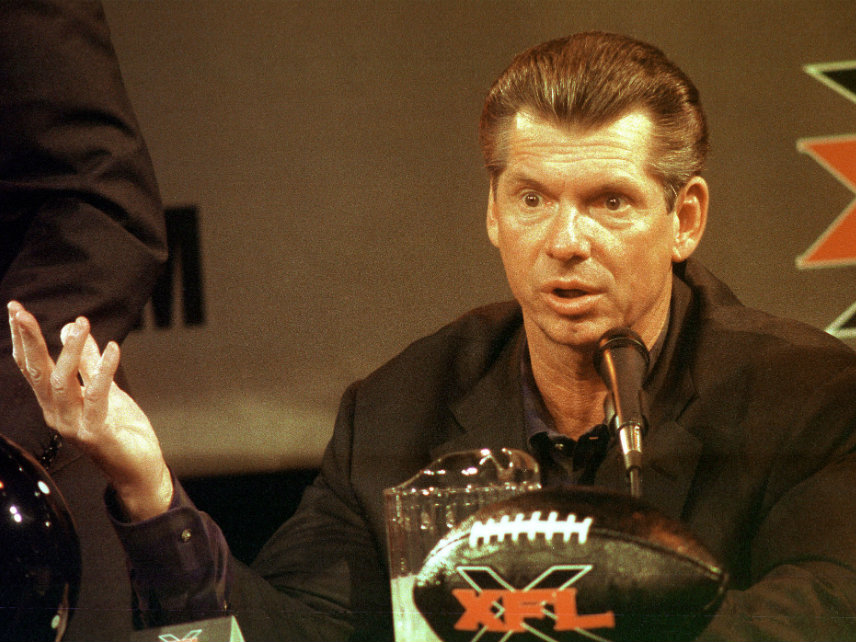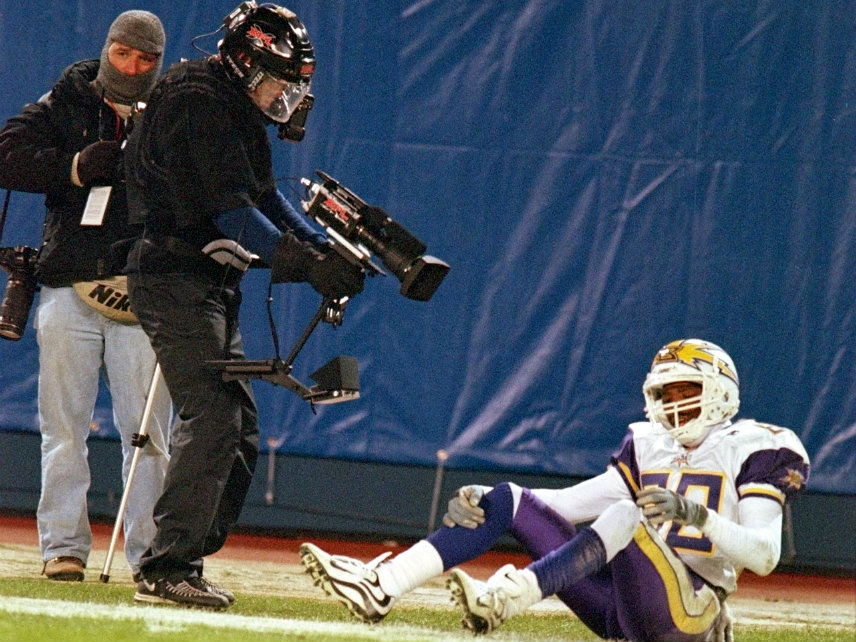The XFL Was a Flop, But It Made the NFL Better
Failures can be fodder for improving other products. Creative destruction needs bad ideas as much as good ones.

The "X" in XFL never stood for anything. It was there literally only because it looked cool.
That's the story in a nutsehll of the XFL, the professional football league dreamed up by professional wrestling mogul Vince McMahon that lasted for all of one season in the early aughts. It was style over substance, flair over football. And now, nearly two decades after it flopped, McMahon has announced the league's resurrection, promising a "family-friendly" version of football where players will stand for the national anthem.
Play is supposed to begin in 2020. For now, there are no concrete plans regarding teams, stadiums, or a television deal. Which means that—like the "X" in the name—the league doesn't really exist at the moment as anything more than an idea, a placeholder.
Even if the new XFL does manage to make it to the field, it's difficult to see this announcement as much more than very expensive publicity stunt by one of the greatest showmen of recent American history. McMahon is testing the thesis that fans have stayed away from NFL games this past year because of a handful of players' political statements, and he's promising to create a league that appeals to your relatives who write angry Facebook posts about Colin Kaepernick.
His league is hardly going to challenge the NFL for American football supremacy, but it might help the NFL get better. After all, that's what the first iteration of the XFL did.
Don't believe it? When you're watching the opening kickoff of next Sunday's Super Bowl, take a moment to appreciate the camera angle being used. Nearly every kickoff, field goal, and punt (along with many replays) in every NFL game is shown via the so-called SkyCam, a camera suspended over the field on a set of wires, giving the audience a low-flying bird's eye view. In many ways it's a better perspective on the game than you get from the traditional sideline camera, and it gives the TV audience a better view of the players than what the fans sitting in the front row get.
And for that, you can thank McMahon. The SkyCam is probably the most longlasting contribution the former XFL made to the game of professional football, or at least to how we watch it. That camera angle is now a staple of NFL broadcasts. The league even used it as the main camera angle for one Thursday night game this season, to mixed reviews.
Even when a single entity dominates a marketplace like the NFL has dominated the market for American professional football for five decades—the NFL, which has a special exemption from federal antitrust laws, has become the epitome of a corporate monopoly—it must continuously evolve to stay on top. Often, those evolutions come from the absorption of ideas pioneered by smaller firms trying to gain a toehold in the market. Even failures, such as the XFL, provide fodder for improvement of other products. Creative destruction needs bad ideas as much as good ones.
The XFL's actual product was bad football. NBC sportscaster Bob Costas called the league a mixture of "mediocre high school football with a tawdry strip joint," and NBC had the contract to broadcast XFL games. Worse, it was forgettable football. Go ahead, name a single team that played in the league's one and only season. You can't. No one remembers the teams, or any of the games, or who won the lone championship (it was, fittingly, the Los Angeles Xtreme).
That first iteration of the XFL, which lasted just a single season in the summer of 2001, was never a serious threat to the hegemony of the NFL. Still, innovation happens on the margins.

Drawing on his background in professional wrestling, McMahon (along with the then-president of NBC Sports, Dick Ebersol, who co-founded the league) devised small but important changes to how games were presented on TV. Besides the SkyCam, the XFL was the first football league to use steadycam-equipped cameramen on the sidelines and near the endzones, and it was the first to have players wear microphones while on the field. Rather than replicating the experience of fans sitting in the stands, as TV broadcasts previously tried to do, McMahon wanted fans to feel like they were on the sidelines or in the huddle with the players, as he explained in ESPN's excellent documentary on the league, This Was The XFL.
Shortly after the XFL's demise, the NFL adopted many of those techniques. They are now standard elements of any game broadcast. Other XFL ideas, like replacing the pre-game coin toss with two players wrestling for a football, were discarded.
The NFL has absorbed innovative ideas from would-be competitors for decades. The fledgling United States Football League, which lasted just three seasons in the 1980s before folding, was the first to allow referees to use instant replay for reviewing calls on the field. The USFL also gave teams the option to try to score two points after a touchdown instead of merely kicking an extra point. (Lower levels of football had previously used the two-point conversion, but the USFL was the first to bring it to the professional game.) Both elements were later adopted by the NFL, and it's hard to imagine a professional football game without them today.
The USFL's most lasting contribution to the NFL, though, might be Donald Trump. The future president was an owner of the USFL's New Jersey Generals franchise, and he encouraged the new league to challenge the NFL's antitrust exemption in court. It did, and it won, but the $1 in damages awarded to the USFL was hardly enough to cover massive court costs that contributed to the league's bankruptcy. Trump later tried to buy the NFL's Buffalo Bills, but was prevented from doing so, possibly because other NFL owners were still upset at Trump's role in the USFL. When the president fires off angry tweets about the NFL, it's not just about politics. There are decades of bad blood.
That mix of politics and sports is also at the heart of McMahon's new XFL, which seems timed to capitalize on NFL fans who have been driven away from the sport by a handful of players' political stances. Whether such an exodus of fans exists is a subject of some debate, but McMahon (like his longtime friend Trump) knows that perception can be as good as reality.
NFL team owners gathered in Minnesota this week for pre–Super Bowl festivities surely are not worried about the second iteration of the XFL threatening their place in American sporting culture. Health issues and the eroding participation in youth football are far larger existential threats.
If they're smart, though, they'll be paying attention to McMahon's latest foray into the sport. In the XFL's second failure, there might be another idea or two worth appropriating.

Show Comments (37)